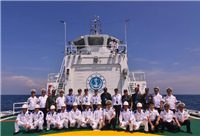

On March 13, the U.S. Navy, U.S. Coast Guard, and U.S. Marine Corps released a revised maritime strategy entitled “A Cooperative Strategy for 21st Century Seapower”. The document was published in seven languages, including a simplified Chinese version.
Compared with the 2007 version, the new strategy involved a series of new concepts being promoted for the first time, such as "Indo-Asia-Pacific region" (Indian Ocean-Asia-Pacific region), "all domain access", and "Electromagnetic Maneuver Warfare". It clearly places "all domain access" at the peak of its priorities among the five basic capabilities of US naval forces.
"All domain access" ability will integrate activities at sea, on land, in the air, in space, and in cyberspace. The capacity includes electromagnetic fields to counter various global maritime defences (e.g., anti-access/area denial capabilities of competitors) to ensure that US forces can freely enter coastal and inland areas of these countries for the purposes of combat. The US media have made it clear that China is one of the target countries for "all domain access".
The new maritime strategy regards China, Russia, Iran and North Korea and other countries as security threats, and represents a significant challenge to China's defences.
On the one hand, the strategy acknowledges that China's expansion of naval activities in the Indian Ocean and the Pacific Ocean has played a positive role in the international community - for example, China has supported counter-piracy in the Gulf of Aden, dispatched hospital ships to participate in humanitarian aid and disaster mitigation, and taken part in large-scale multi-national naval exercises. On the other hand, it makes groundless accusations against China's legitimate actions in safeguarding maritime rights and interests, and similar groundless accusations about China's 'use of force' or 'intimidation' in the maintenance of sovereignty. It also criticizes a 'lack of transparency' in China's military intentions, which has supposedly led to tension and turbulence that might result in mistaken judgments and escalation of problems.
The new US maritime strategy represents a Cold War mentality.
First, the US military continues to regard China as its potential military adversary, continues to develop operational capability against China, continues to strengthen its military deployment around China and continues to strengthen its military alliances with Japan, the Philippines, Australia and other countries. It turns a blind eye to China's efforts and restraint in dealing with maritime disputes with neighboring countries and continues to use these maritime disputes as a lever to restrict China's development.
Second, the "all domain access" concept aims to give US military forces free access to the coastal seas and even the inland areas of other countries. This is undoubtedly hegemonic thinking.
In fact, the new US strategies such as "Asia-Pacific" or "Asia-Pacific rebalancing" are moves against China. They are not conducive to building a new type of China-US relationship which adapts itself to a new military relationship, nor are they helpful in any way to regional and world peace and stability. The US should direct its efforts to building bridges with China and to maintaining security and stability in the region and elsewhere in the world.
The author is Zhang Junshe, a researcher with the Naval Military Studies Research Institute of the People's Liberation Army.
This article was edited and translated from 《美海上新戰略突顯對華兩面性》, source: People's Daily Overseas Edition
 J-11 fighters in air exercise
J-11 fighters in air exercise Beauties dancing on the rings
Beauties dancing on the rings Attendants-to-be join Mr. & Miss Campus Contest
Attendants-to-be join Mr. & Miss Campus Contest Beijing's toughest anti-smoking law takes effect
Beijing's toughest anti-smoking law takes effect Family lives in cave for about 50 years in SW China
Family lives in cave for about 50 years in SW China PLA soldiers operating vehicle-mounted guns in drill
PLA soldiers operating vehicle-mounted guns in drill Blind carpenter in E China's Jiangxi
Blind carpenter in E China's Jiangxi China hosts overseas disaster relief exercise for the first time
China hosts overseas disaster relief exercise for the first time 20 pairs of twins who will become flight attendants in Sichuan
20 pairs of twins who will become flight attendants in Sichuan Obama is sowing discontent in S.China Sea
Obama is sowing discontent in S.China Sea Rescuers work through night to reach cruise ship survivors
Rescuers work through night to reach cruise ship survivors Driving through limbo
Driving through limbo Facing down MERS
Facing down MERSDay|Week